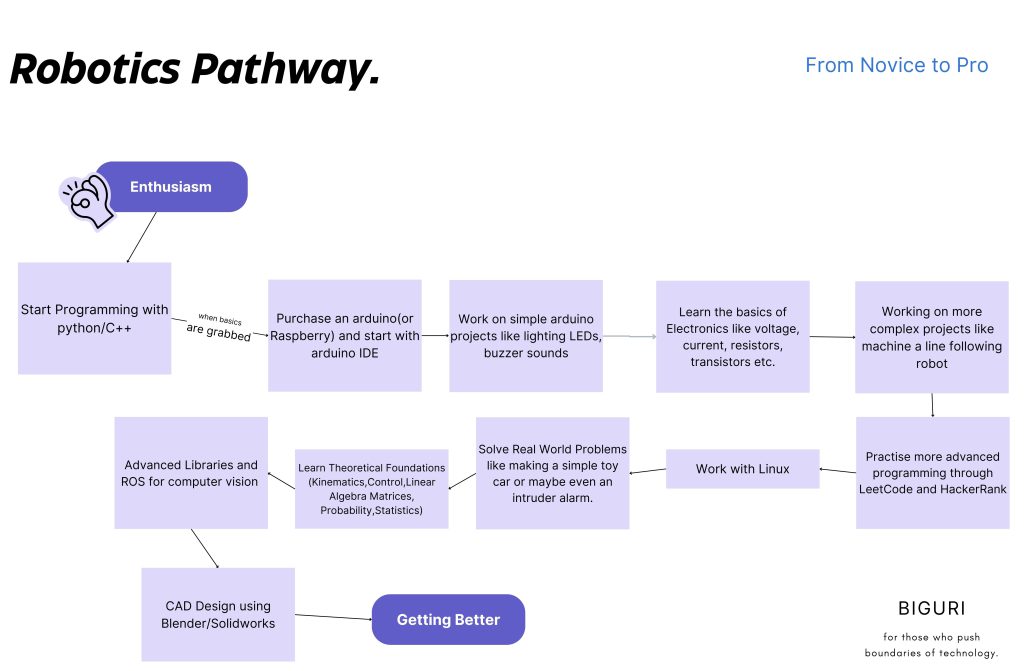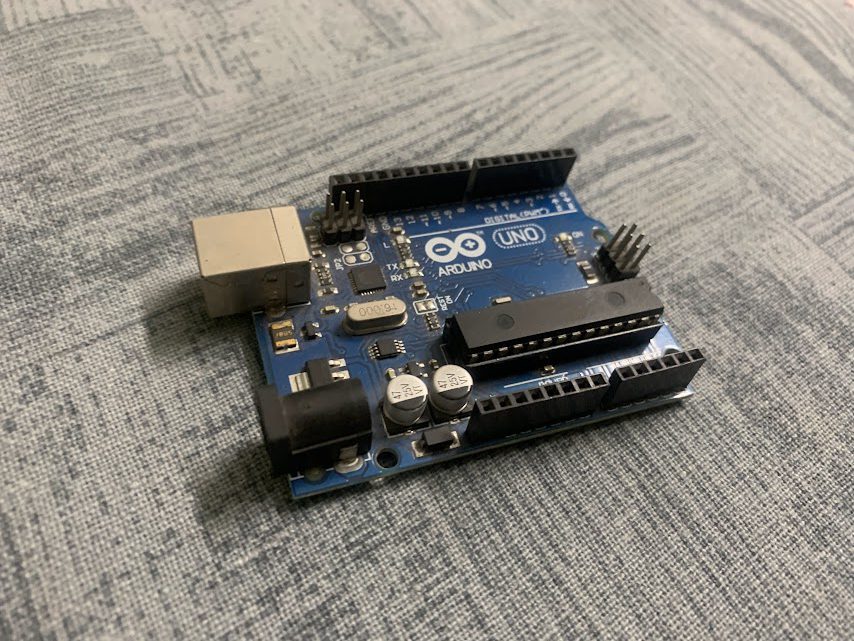Getting into Robotics: From Novice to Pro
Contents:
- Part 1 : The Novice
- Introduction to Robotics
- Getting Started with Microcontrollers and Basic Projects
- Programming
- Working with Microcontrollers
- First Projects
- Part 2 : The Enthusiast
- Building Advanced Machines
- Advanced Programming
- Embedded Systems
- Real-world Applications
- Building Advanced Machines
- Part 3 : The Roboticist
- Transitioning to Professional Robotics
- Theoretical Foundations
- Advanced Libraries
- CAD design
- Continuous Learning
- Transitioning to Professional Robotics
Part 1: The Novice – Embarking on the Robotics Voyage

The first phase of your robotics journey is about understanding the fundamental principles, familiarising yourself with necessary tools and technologies, and getting your hands dirty with beginner-friendly projects.
We believe that the best way to start robotics is through practically doing it.
Introduction to Robotics
Robotics is an interdisciplinary field, merging concepts from computer science, mechanical and electrical engineering.
It involves the design, construction, and operation of robots, machines capable of performing tasks independently or semi-autonomously.

Getting Started with Microcontrollers and Basic Projects
Beginners usually start with user-friendly microcontrollers such as Arduino or Raspberry Pi.
These tiny, programmable computers are capable of interacting with physical elements like sensors, LEDs, motors, etc.
1. Programming:
The basis of controlling microcontrollers is coding. Python and C++ are commonly used languages in robotics.
Python, known for its simplicity, is a great starting point, while C++ provides lower-level access to hardware and higher execution speed.
Resources like Codecademy[python] and freeCodeCamp[C++,youtube] provide in-depth courses for these languages. Arduino IDE is a good starting point.
2. Working with Microcontrollers:
Arduino and Raspberry Pi have extensive online communities and documentation. For Arduino, you could start with the official Arduino website. Raspberry Pi resources are plentiful on their official site, too.

You can start with lighting up LEDs, making a buzzer sound etc.
3. First Projects:
Initial projects often involve building simple robots. For instance, a light-following robot involves using photoresistors (light sensors), a basic chassis, and programming the Arduino to control the motors based on input from the sensors.
Websites like nevon projects provide various ideas for new tech projects.
Part 2: The Enthusiast – Expanding Your Horizons in Robotics
Moving onto the intermediate level, you’re now delving deeper into the intricacies of robotics. This phase is about creating more complex machinery and potentially integrating robotics into your workplace or small business.
Building More Advanced Machines
With a grasp on fundamental concepts, it’s time to challenge yourself with more sophisticated projects and applications.
1. Advanced Programming:
Mastering data structures, algorithms, and object-oriented programming will allow you to code more complex robotic behaviours.
Websites like LeetCode and HackerRank provide challenging problems to improve your programming skills.
2. Embedded Systems:
Transition from working on your laptop to programming mini-computers such as Raspberry Pi.
Familiarise yourself with Linux operating systems, as many robotics software and libraries are designed for Linux environments. The Ubuntu environment makes it very easy to install various libraries specialised for computer vision and robotics.
That’s why you often see developers complimenting Linux.
3. Real-world Applications:
Start identifying real-world issues that your robots can solve. This could range from automating a process at home to creating a product for a small business.
It could be making a simple toy car or maybe even an intruder alarm.
Part 3: The Roboticist – Mastering the Art of Robotics
The expert level in your robotics journey involves keeping up with the rapidly changing field and honing your skills to a professional standard.
Transitioning to Professional Robotics
At this point, the goal is to cement your place as a robotics professional by developing specialised skills and staying updated with the latest advancements.
1. Theoretical Foundations:
Depending on your area of interest in robotics, you need to delve deeper into the theories behind it.
Explore concepts in robotic arm manipulation (kinematics),
perception (computer vision, linear algebra, matrices),
and machine learning(probability, statistics, maths).
Check out our article on machine learning as a high school student.
Kinematics: It’s the science of motion – tells you how to command your robot to move in a specific way.
Linear Algebra: This is the language of shapes and spaces, helping your robot understand and navigate its environment.
Matrices: These are the tools in linear algebra, used for keeping track of your robot’s position and orientation.
Probability: This is the mathematics of uncertainty, helping your robot make sense of noisy data and make predictions about what to do next.
2. Advanced Libraries and ROS:
(using a developing algorithm)to train
this robot to start walking on its own…
Implement machine learning and computer vision algorithms on your robot using advanced libraries like TensorFlow and OpenCV.
Familiarise yourself with the Robot Operating System (ROS), a flexible framework for writing robot software. It provides tools, libraries, and conventions that simplify the task of creating complex and robust robot behaviour.
The ROS documentation is quite confusing but is do able.
It might seem complex but once you give it some time, it is possible.
3. CAD Design:
For those interested in designing complex robots, learning 3D design software like Blender or SolidWorks can be invaluable. These tools enable you to visualise and create your own robotic models.
Blender is free and easy to use, but solidworks is more specialised to create machines and robots. That’s why most professionals prefer it.
4. Continuous Learning:
The field of robotics is always evolving, so your learning should never stop. Depending on your area of specialisation, continue to expand your knowledge, whether that’s exploring more advanced control algorithms, enhancing your coding skills, or refining your robotic designs.
Subscribe to various magazines related to electronics and programming to make this progress consistent.
The journey from newbie to professional roboticist is meant to be full of exploration, discovery, and of course, plenty of hands-on robotics fun. Remember, the best way to learn is by doing. So, don’t be afraid to get your hands dirty, make mistakes, and keep improving along the way.
Hi there! I’m a high school tech enthusiast who loves programming, machine learning, and electronics and technology. I have worked on artificial intelligence, websites, apps and electronics. Fitness buff by day, coder by night, currently building a site to make tech product selection a breeze for you. Join me on this journey to discover the best in tech!
